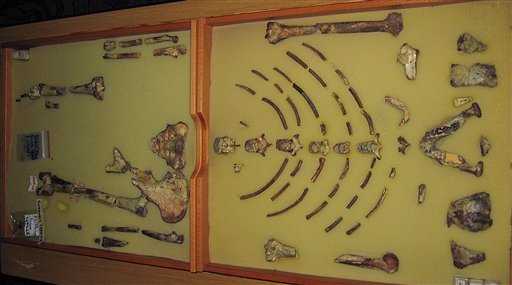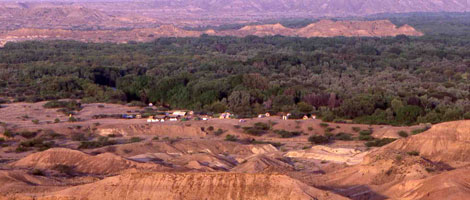Lucy (Dinkinesh), the world’s most famous fossil, will be on display for the first time outside of Ethiopia in the world-premiere special exhibition Lucy’s Legacy: The Hidden Treasures of Ethiopia. Photo courtesy of the Houston Museum of Natural Science.
HOUSTON — Ethiopia is the land of Lucy (Dinkinesh), the cradle of mankind, the birthplace of coffee, the purported resting place of the Ark of the Covenant—and home to legions of Bob Marley fans.
3.2 million-year-old Lucy, the oldest and most complete adult human ancestor fully retrieved from African soil, and five million years of Ethiopia’s diverse history and culture will be on display at the Houston Museum of Natural Science, one of the nation’s most heavily attended museums.
After its premiere in Texas, the exhibition will tour other museums in the United States.
Donald Johanson discovered Lucy in 1974 in a maze of ravines in the Afar region of Ethiopia, near Hadar. She was named after the Beatles’ song Lucy in the Sky with Diamonds, which was played during a celebration of the discovery. The Ethiopian people refer to her as Dinkenesh, (Amharic for you are wonderful).
The discovery of Lucy yielded an entirely new species of human ancestor, known as Australopithecus afarensis, or “southern ape of Afar,” after the region of Ethiopia where the bones were found.
“What we know about human evolution comes to us from the African continent, and in large part, from Ethiopia,” said Dirk Van Tuerenhout, Ph.D, curator of anthropology.
“In addition to its importance to human prehistory, the recorded history of Ethiopia has many surprising and fascinating aspects, from its tradition of beautiful art to its diverse religious community. Visitors to Lucy’s Legacy will have the opportunity to explore all of the intriguing characteristics that make this country unique.”
In addition to Lucy’s original fossilized remains, other important paleoanthropological discoveries will also be represented to complete the current account of human evolution as known to scientists today.
“The display of original artifacts is crucial to the educational impact of museum exhibitions,” said Joel A. Bartsch, president of the Houston Museum of Natural Science. “Anyone can make a copy. But the experience of standing before an authentic historical artifact, whether ancient parchments or multi-million-year-old fossils, is a call to the intellect, to discover more about the world and perhaps even more about yourself. The Lucy fossil in particular evokes a strong response from everyone who sees her, and as such, she is the ultimate goodwill ambassador for Ethiopia. Lucy not only validates Ethiopia’s claim as the Cradle of Mankind, she also introduces viewers to the rich cultural heritage that has flourished in Ethiopia over the course of the last 3,000 years, and to the vibrant country that Ethiopia is today.”
The international exhibition is organized by The Houston Museum of Natural Science in collaboration with the Ministry of Culture and Tourism of Ethiopia and the Ethiopian Exhibition Coordinating Committee.
National funding is provided by Ethiopian Airlines and The Smith Foundation. Local funding is provided by METRO, BP, The Hamill Foundation and the Albert and Ethel Herzstein Charitable Foundation.
Related news and links:
New Yorkers Received Rare Treat at MOBIA: Ethiopian Art from The Walters Art Museum. By COLLEEN LUTOLF

Lucy’s Legacy: The Hidden Treasures of Ethiopia

—————————————————–
Lucy Comes to America
August 6th, 2007
BY STAFF WRITER
New York – The 3.2 million-year-old Lucy (Dinknesh ) was secretly flown out of Ethiopia overnight for a 6-year controversial tour of the United States, the Associated Press reported.
The Smithsonian Institution in Washington had warned that experts don’t believe the fragile remains should travel.
Lucy, often referred to as the origin of human beings, might have been taken out of Ethiopia either late Sunday or early Monday, according to press reports quoting employees at the Ethiopian Natural History Museum in Addis Ababa.
A world premier exhibition entitled Lucy’s Legacy: The Hidden Treasures of Ethiopia will open at the Huston Museum of Natural Science on August 31, 2007.

Les Neuhaus AP Photo – The framed hominid fossil “Lucy,” is seen at a exhibition at the Ethiopian Natural History Museum in the Ethiopian capital of Addis Ababa, Tuesday, Oct. 24, 2006. The 3.2 million-year-old Lucy skeleton has left Ethiopia for a tour of the United States _ a trip that some say is simply too risky for one of the world’s most famous fossils.
According to the Museum, in addition to the fossil of Lucy, over 100 artifacts such as ancient manuscripts and royal artifacts from a dynasty Ethiopians believe stretches back to the son of the biblical King Solomon and the Queen of Sheba will be on display.
National funding for the exhibition is provided by The Smith Foundation and Ethiopian Airlines.
Lucy was found by Donald Johanson and Tom Gray on the 24th of November, 1974, at the site of Hadar in Ethiopia.
Later in the night of November 24th, there was much celebration and excitement over the discovery of what looked like a fairly complete hominid skeleton. There was drinking, dancing, and singing; the ‘ Beatles’ song “Lucy in the Sky with Diamonds” was playing over and over. At some point during that night no one remembers when or by whom the skeleton was given the name “Lucy.” The name has stuck. Although Ethiopians refer to her endearingly as Diniskinsh (You are wonderful).
Related news and links:
Lucy’s Legacy: The Hidden Treasures of Ethiopia


Wow what a shameful action, it is very embarrassing.
Went to see the exhibit in houston and it was awesome!! Happy Millenium Ethiopia
It is interesting that a few bones can be used to explain the supposed “evolution” of mankind. But what is the real evidence besides the speculation of those who are looking for evidence for evolution. Evolution is the greatest fraud every imposed on science! It is time to expose it as the fraud it is. It is interesting how this can be passed off as science by educated people!